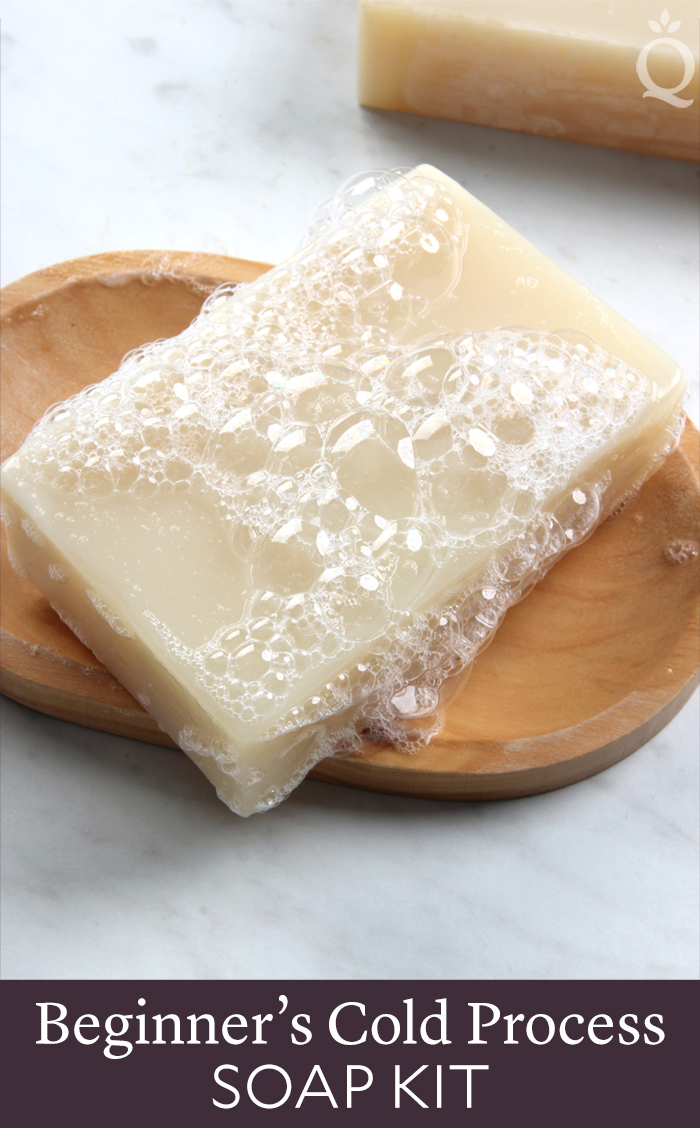
It’s best to start with an easy recipe when making cold process soap for the first time. The Beginner’s Cold Process Soap Kit is specially designed for just that – it includes ingredients for a simple and straightforward bar of soap.
The Beginner’s Cold Process Soap Kit is one of our oldest kits, so it was time for an update. It now includes a durable silicone mold for perfectly-shaped bars every time. It also comes with printed, easy-to-follow instructions to make the process as smooth as possible.
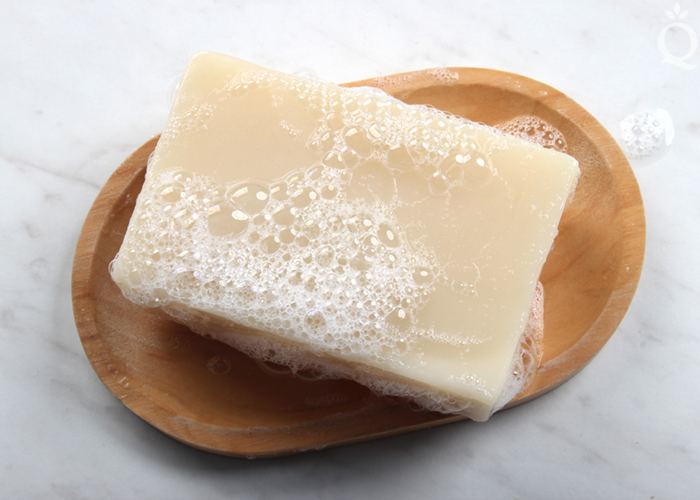
If you’ve never made cold process soap before, the Basics of Cold Process Soapmaking video series on Soap Queen TV is a great place to start learning. It covers soap basics like lye safety and how to use fragrance oils. After your first batch, you’ll be hooked.
The Beginner’s Cold Process Soap Kit Includes:
10″ Silicone Loaf Mold
1 Jar Sodium Hydroxide Lye
1 lb. Coconut Oil
1 lb. Palm Oil
1 lb. Olive Oil
4 oz. Castor Oil
2 oz. Apple Sage Fragrance Oil
Printed Instruction Card
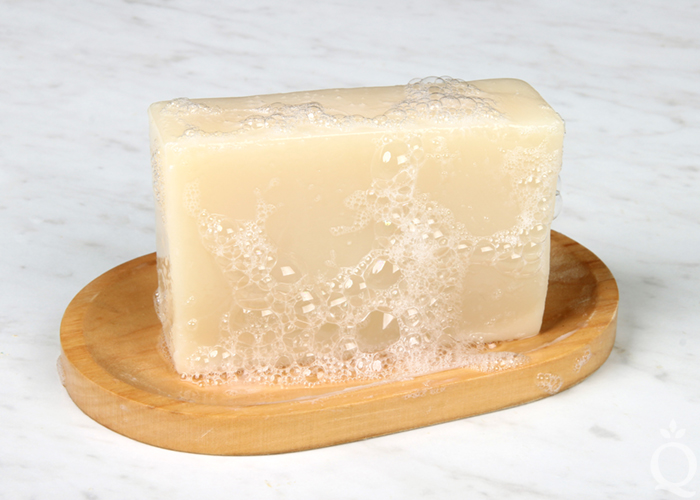
- 10" Silicone Loaf Mold
- 13.5 oz. Olive Oil Pure
- 9 oz. Coconut Oil
- 9 oz. Palm Oil
- 1.5 oz. Castor Oil
- 4.6 oz. Sodium Hydroxide Lye
- 10.9 oz. Distilled Water
- 2 oz. Fragrance Oil
- precautions are taken. Wear gloves and protective goggles when handling lye. Work in a well-ventilated area. Use heat-safe glass and stainless steel products (never aluminum) when working with lye.
- Completely melt the bags of coconut oil and palm oil in the microwave before weighing. Weigh the coconut oil, palm oil, castor oil, and olive oil into a glass container with a volume of at least 64 oz. Set aside.
- With gloves and goggles on, weigh out the lye in a glass container. Then weigh the water and fragrance oil in separate glass containers.
- With gloves and goggles on, prepare the lye water mixture using heat-safe glass and stainless steel products. Add the lye to the distilled water (never the other way around). Stir until all the lye is dissolved and the mixture turns clear. Take care not to breathe in the fumes. Set the lye water aside to cool in a safe place where it will not be disturbed.
- Wait until the lye water cools to between 110° F to 130° F, and the oils are between 110° F and 130° F. If necessary, reheat the container of oils in the microwave until they are the correct temperature.
- With gloves and goggles on, add the lye water to the melted container of oils. Slowly pulse the stick blender on and off in short bursts, stopping and using it to stir between bursts. Move the blender around the bowl so all parts of the mixture are getting blended.
- Once you’ve achieved a pudding-like texture (known as medium trace) and all oils are fully mixed, add the measured fragrance oil and stick blend until combined.
- Once the fragrance is fully incorporated, pour the soap batter into the 10” Silicone Loaf Mold. Use a silicone spatula to scrape out any remaining soap. Tap the mold on the counter to get rid of bubbles. Optional: spray top with rubbing alcohol to prevent soda ash.
- Place the mold in a safe place where it will not be disturbed. Allow the soap to harden in the mold for 2-4 days. Remove the soap from the mold. If it does not unmold easily, wait another day.
- Using a sharp knife, cut the soap to your desired bar size. For the best results, allow the soap to cure for 4-6 weeks in a well-ventilated area before use.
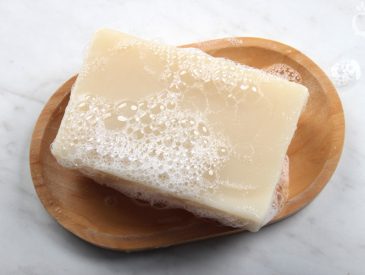



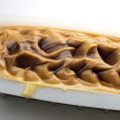
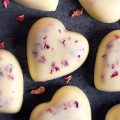
we want to start making soap from goat milk. looking for a kit that includes everything that you need to make the soap. equipment as well as what you have listed on your site. do you know where we can find this? we would like to able to product as much as 100 bars.
We don’t have any specifically goat milk kits though we do have a lot of great cold process kits you can make with goat milk instead of distilled water as your liquid. I would probably recommend the Natural Soap Kit for Beginners. You would need to buy some of the utensils / tools separately though
https://www.brambleberry.com/search?q=natural+kit+for+beginners&lang=default
Find out more about how to add lye to milk here: https://www.soapqueen.com/bath-and-body-tutorials/tips-and-tricks/how-to-add-lye-to-milk-for-cold-process-soap/
Can you please tell me the superfat if any in this recipe?
We used a %5 superfat.
Is this general recipe safe for dogs?
This is a question that would best be answered by your pet’s veterinarian, we don’t have much expertise for animal soaps.
I did not buy the kit, but used this recipe for my first try at making soap. I did not use fragrance. Will that make a difference in the recipe?
That won’t make a big difference in the recipe except you will have unscented soap. Some people prefer unscented soaps, especially if they have sensitive skin.
Can you tell me if this would be all vegan?
Since non of the ingredients are animal based, the product would be considered Vegan.
could this recipe be used as a melt and pour as well?
Melt and pour is an already-made base. That means it doesn’t need any oil added – all you have to do is melt it, add fragrance and color, and pour into molds. This post talks more about that: http://www.soapqueen.com/bath-and-body-tutorials/melt-and-pour-soap/free-beginners-guide-to-soapmaking-melt-and-pour/
You can use any of our bases and add the same fragrance as this recipe. Find out how much to add with our Fragrance Calculator: https://www.brambleberry.com/Pages/Fragrance-Calculator.aspx
And find all our bases here: https://www.brambleberry.com/SFIC-Soap-C647.aspx
Can I add color and exfoliat to this recipe? If so how much?
Yes, you can add both. For color, pigments and micas work well. Mix 1 teaspoon of the color with 1 tablespoon of a lightweight liquid oil like sweet almond. Add 1 dispersed teaspoon at a time at trace until you get a color you like.
Pigments: https://www.brambleberry.com/Pigments-C45.aspx
Micas: https://www.brambleberry.com/Micas-C46.aspx
Learn more about working with colors here: http://www.soapqueen.com/bath-and-body-tutorials/tips-and-tricks/talk-it-out-tuesday-colorants/
For exfoliants, start with 1 teaspoon per pound of soap at trace and go from there.
Learn more about exfoliant options here: https://www.soapqueen.com/bath-and-body-tutorials/tips-and-tricks/all-about-exfoliants/
Hello, I intend to buy the soap making book, until then can you tell me if this recipe will work for an in the pot swirl or spoon plop method. Does this soap have much lather? I Know that you have videos for these using quick mix but I would like to start practicing with My own oils and order larger quantities of the ones I need. Thanks
This recipe creates firm bars and the castor and coconut oil give it a good amount of lather. It will also work for a swirl or spoon plop. Just blend to a thin trace so you have time to work with the design.
Learn more about thin trace here: https://www.youtube.com/watch?v=1XK4VjBPTBI
This post on formulating recipes is helpful as well: http://www.soapqueen.com/bath-and-body-tutorials/tips-and-tricks/formulating-cold-process-recipes/
Hiya, i’m very new to soap making and I don’t want to use palm oil. What would be the best substitute for it?
Babassu oil can be used in place of palm oil: https://www.brambleberry.com/Babassu-Oil–P6807.aspx
You can also add a hard oil like cocoa butter up to 15% to add firmness like palm oil does. Coconut oil or tallow up to 33% work as well. Read more about common oils and what properties they add to soap here: http://www.soapqueen.com/bath-and-body-tutorials/tips-and-tricks/free-beginners-guide-to-soapmaking-common-soapmaking-oils/
This post on substituting oils has some great information too: http://www.soapqueen.com/bath-and-body-tutorials/tips-and-tricks/how-to-substitute-oil-in-cold-process-recipes/
Hello,
Can I use any other essential oil in this recipe? and if it’s EO, should I still use it in the same quantity? Can I use Rosemary EO in this recipe?
Yes, you can use any other skin-safe essential oil in this recipe. Find out how much to add with our Fragrance Calculator: https://www.brambleberry.com/Pages/Fragrance-Calculator.aspx
Find our skin-safe essential oils here: https://www.brambleberry.com/Essential-Oils-C157.aspx
Rosemary essential oil: https://www.brambleberry.com/Rosemary-Essential-Oil-P3817.aspx
Una consulta,tengo unos lotes de jabon que ya estan curados pero no me gustan unos porque el color es muy fuerte y otros porque no huelen muy bien,se pueden rallar y agregar a la mezcla de un jabon nuevo,quizas en la traza?
perdon quize decir si se pueden rallar los jabones curados y agregar en la formula de un nuevo jabon?
You can do this. You could grate up the bars and introduce them to cold process soap batter. This is sometimes referred to as “confetti soap,” because the soap pieces look like confetti once the soap is cut into bars. We did this in the tutorial below.
Violet Confetti Soap: https://www.soapqueen.com/bath-and-body-tutorials/violet-confetti-cold-process-soap-tutorial/
Another technique would be grating the soap, and melting it down over low heat along with some distilled water. This is called rebatching soap. This works best with soap that is fresh (not fully cured), but it can still be done with cured soap as well. We show how to rebatch soap in the video below.
How to Make Rebatch Soap: https://www.youtube.com/watch?v=2YcCV0AWutw
Hello, should I put a towel over the soap while I’m waiting the 2-3 days to take it out of the mold? If so what kind? Also what do you put the soap that’s curing in for the 4-6 weeks? Meaning a container with the lid off or on a plate?
When you cover the soap it forces something called gel phase. That can make the colors pop and give the soap a slightly shiny appearance. Read more about that here: http://www.soapqueen.com/bath-and-body-tutorials/tips-and-tricks/gel-phase/
If you do want your soap to go through gel phase, you can leave that towel on for 24 hours. After that, leave the soap uncovered for 2-3 days until it’s hard enough to unmold and cut. It will cure best in a cool, dry place with good airflow. Placing the bars on a bakers rack is a good option, learn more here: http://www.soapqueen.com/bath-and-body-tutorials/tips-and-tricks/how-to-store-handmade-bath-products/
Hello im a beginner wondering if there is a video for beginners that is easy to follow? thanks so much
Yes, we have a four-part video series on how to make cold process soap that’s really helpful. You can find that video here: https://www.youtube.com/watch?v=yR6ttCSrLJI&list=PLAADF6209996265D2
Find more video tutorials here: https://www.youtube.com/user/soapqueentv/videos
Hello and thank you for all these wonderful tutorials! I am a total beginner. I have dedicated the holidays to teaching myself soap making… but I’m having a hard start. I have made 4 batches so far and all of them have been somewhere on the scale between “Total Disaster” and “Is this Soap?” 😀 I think I’m having lye issues, as I am having loads of troubles getting it to dissolve in water and I need to dilute to something around 25% or less concentration just to get it full dissolved but them I’m ending up with SUPER oily/fatty batches that take hours to trace (with a stick blender)… Is there a place on here where I could post or send images with more details of my process etc? I would HUGELY appreciate any and all help! Thank you in advance.
Yes absolutely, you can email [email protected] or message us on Facebook for help: https://www.facebook.com/BrambleBerry/
Thank you so much. Email sent!
can i add color to this recipe?
You can, that will look nice. Powder pigments work well in cold process soap. To use them, mix 1 teaspoon of the colorant into 1 tablespoon of a lightweight liquid oil like sweet almond. Then, add 1 dispersed teaspoon of color at a time at trace until you get a shade you like.
Pigments: https://www.brambleberry.com/Pigments-C45.aspx
Sweet almond oil: https://www.brambleberry.com/Sweet-Almond-Oil-P3205.aspx
Learn more about working with color in this beginner series: https://www.youtube.com/watch?v=yR6ttCSrLJI&list=PLAADF6209996265D2
hello,
If i want my soap to have a natural green color like that of a aloe vera leaf. What powdered pigment would you recommend?
I would recommend Green Chrome Pigment: https://www.brambleberry.com/Green-Chrome-Oxide-Pigment-P4042.aspx
Mix 1 teaspoon of the color with 1 tablespoon of a lightweight liquid oil like sweet almond. Add 1 dispersed teaspoon at a time at trace until you get a color you like.
Hi,
I am having a very weird issue.
Some pieces of soap have gotten moulding on the surface. Now these pieces are almost a year old. I had gifted some to a friend and I still have others of the same batch. Its interesting that I had gifted her 7 soaps yet only 3-4 have gotten moulding on them. The others that are there with her havent got any other form of moulding. Even the other pieces that I have havent got any moulding. Its just those 3-4 pieces.
Any idea as to what couldve happened?
Soap has a pH level that doesn’t allow mold to grow. However, if there are fresh items on top like flowers or orange peels, they can mold. Are there any fresh items on top of the bars? Or are there orange spots?
Hi Kelsey
I want to try the creamy cow milk soap recipe. I couldn’t post my question under the recipe. I wonder if you could help with these questions :
1-milk should be pasteurized right? I have frozen cubes of pasteurized milk for about 15 days or more do you think I can still use them?
2- when I put the recipe in soapcalc.net I have to insert the water option and option 1 ( water as % of oils) is automatically set at: 38. do you recommend changing and using option 3 (water: lye) ratio?
3- I don’t have palm or Shea Butter, so I will drop them off. how the recipe percentages should look like in this case? Thank you alot for your kind help
We’ve used both pasteurized and raw milk and they work well. The cubes you have are just fine to use. Learn more about working with milk here: http://www.soapqueen.com/bath-and-body-tutorials/tips-and-tricks/how-to-add-lye-to-milk-for-cold-process-soap/
I’m not familiar with the other calculator, so I’m not sure. I’d recommend using our Lye Calculator because that’s what we’ve tested the recipes with: https://www.brambleberry.com/Pages/Lye-Calculator.aspx
Without the shea and palm, you can increase the coconut oil to 33% and the rest can be covered with olive oil. Both palm and shea help harden the bars, so without them the recipe will be pretty soft. You may need to wait a week or more before unmolding.
Thank you Kelsey
I don’t love to use your lye calculator but it requires signing up for an account which means extra effort 😉
Regardless of the calculator what do you recommend for those values to be (water as % of oil) or the water :lye ratio. when you add a recipe with % do you have these values already incorporated in the recipe? Because what usually happens is that I use the % you recommend and also set the option of (water as % of oils) ro 38 so I don’t know if this affects the outcome…
By the way, I didn’t find these options in your calculator. For a beginner it is sometimes helpful to have them because it is somehow complicated to just figure the values manually.
Ops! I meant to say: I’d love to use your calculator. just a typo
Our liquid amount is set to 33%. Also, you don’t need to sign up for an account to use our Lye Calculator. Just plug in your amounts and hit calculate: https://www.brambleberry.com/Pages/Lye-Calculator.aspx
Hi Kelsey
By the liquid amount you also mean: water as % of oils? Forgive my elementary questions: So when you post a recipe with percentages you already have that liquid amount counted for?What happens then when your recipe percentages are inserted in another calculator in which there is the value I told you about: (water as % of oils= 38)? I have to insert something there.
Yes, that is water as the percentage of oils. I’m not sure how to work with the other calculator so I would recommend contacting them to learn more.
Hello,
Thank you very much for your great posts, I have a general problem in soap making. I decrease temperature of my lye solution around 35-40 degrees Celsius. I also decrease temperature of my oil part (coconut oil, pomace and castor oil) to 40 degrees Celsius and pour lye to oil part. However as soon as I pour them the soap batter gets thickened. It gets like a putty. What am I doing wrong ?
(I use a stick blender to mix them). It gets to thick that I cannot even pour into molds. It gets there like in 20-30 seconds.
Thank you for your reply.
I’m wondering if you may be getting false trace. When the cool lye water is added to the cool oils, they can start to solidify before the soap is emulsified. This post talks more about false trace: https://www.soapqueen.com/bath-and-body-tutorials/tips-and-tricks/spot-prevent-false-trace/
Try increasing your lye and oils to 45C. At that temperature they should stay melted and give you more time to work.
Thank you Kelsey! I am new to this so before I got your reply I had made some:around 48% olive, 36% coconut and 14% castor. Calculator gave 37 for the hardness and lodine: 58 so not sure how hard the bars would be. I love the hardness in the picture above. What if I don’t have a substitute for Palm oil? Did you mean that if I take the palm oil off without adding a substitute, (coz I can’t find coconut butter) then I can decrease olive oil by 15%?
You can leave the palm oil out completely and increase the coconut oil and add the cocoa butter. Palm oil adds hardness to the bars, so without it they will be softer. Adding hard oils like coconut and cocoa butter helps harden the bars.
You can also use babassu as a replacement for palm oil. You can use the same amount called for in this recipe: https://www.brambleberry.com/Babassu-Oil–P6807.aspx
Thank you! How about Shea Butter instead of Palm oil? I don’t have access to cocoa butter or babassu. I also would love to see beginner body wash/body shampoo recipes, could not find any Here. Thank you so much!
You can use shea butter but we only recommend it up to 15%. You can replace some of the olive oil with shea. I would also recommend reducing the castor oil to 2-5%. More than 5% can make the bars fairly soft and sticky.
Learn more about common oils and how much to use in your recipe here: http://www.soapqueen.com/bath-and-body-tutorials/tips-and-tricks/free-beginners-guide-to-soapmaking-common-soapmaking-oils/
And this post on formulating recipes is helpful as well: http://www.soapqueen.com/bath-and-body-tutorials/tips-and-tricks/formulating-cold-process-recipes/
You can use our premade bases to make a nice body wash. This post tells you how to work with them: https://www.soapqueen.com/bath-and-body-tutorials/tips-and-tricks/how-to-use-and-thicken-liquid-soap-base/
We used one of those bases to make this Easy Scrubby Body Wash: https://www.soapqueen.com/bath-and-body-tutorials/scrubby-body-wash-diy/
Hello Kelsey
Thank you so much. The tutorial is for liquid base soap which I don’t have. Can I use one of the cold process or hot process soaps as a base to make a body wash? At what stage can the bar be melted to make the body wash? After it cures? Maybe I could melt the bar and add more oils and water to it but I don’t know how much. Would you please help me with this? thank you again for all your work
No, liquid soap uses a different method and a different kind of lye: https://www.brambleberry.com/Potassium-Hydroxide-2-pounds-P4730.aspx
We use our premade bases for liquid soap, so I’m not very familiar with formulating recipes. This post by Lovin’ Soap has great information on making liquid soap though: http://www.lovinsoap.com/2010/09/liquid-soap-lets-formulate-a-recipe/
If you want to work with a premade base, you can find ours here: https://www.brambleberry.com/Liquid-Bases-C15.aspx
And learn how to work with them here: https://www.soapqueen.com/bath-and-body-tutorials/tips-and-tricks/how-to-use-and-thicken-liquid-soap-base/
Hello Kelsey
I mean can I use a soap by melting the bar to make body wash/body shampoo? Or are you saying that the base SHOULD be liquid soap instead?
If you make a solid bar, it will stay solid at room temperature. If you want a liquid base, you’ll need to start with potassium hydroxide and use the method linked above.
If you want a solid bar, you can use the cold or hot process method. That uses sodium hydroxide lye: https://www.brambleberry.com/Sodium-Hydroxide-Lye-P3037.aspx
Hello
Thank you very much for posting this recipe. Can I use the same recipe , take off the palm oil, and make it HOT PROCESS soap so that I can start to use the soap faster?anything would change? I would use smaller amounts of oils.
Thank you for your reply
You can leave out the palm oil if you like. I would recommend increasing the coconut oil to 33% and adding in another hard oil like cocoa butter up to 15% (you can add 15% less olive oil). That will help make the bars firmer.
Learn more about substituting oils here: http://www.soapqueen.com/bath-and-body-tutorials/tips-and-tricks/how-to-substitute-oil-in-cold-process-recipes/
And learn more about formulating recipes here: http://www.soapqueen.com/bath-and-body-tutorials/tips-and-tricks/formulating-cold-process-recipes/
You can hot process this recipe. The main difference is that you’ll add the fragrance when the soap is done cooking, rather than at trace. Learn more about hot process soap here: https://www.youtube.com/watch?v=mxTXwxbpzLM&t=326s